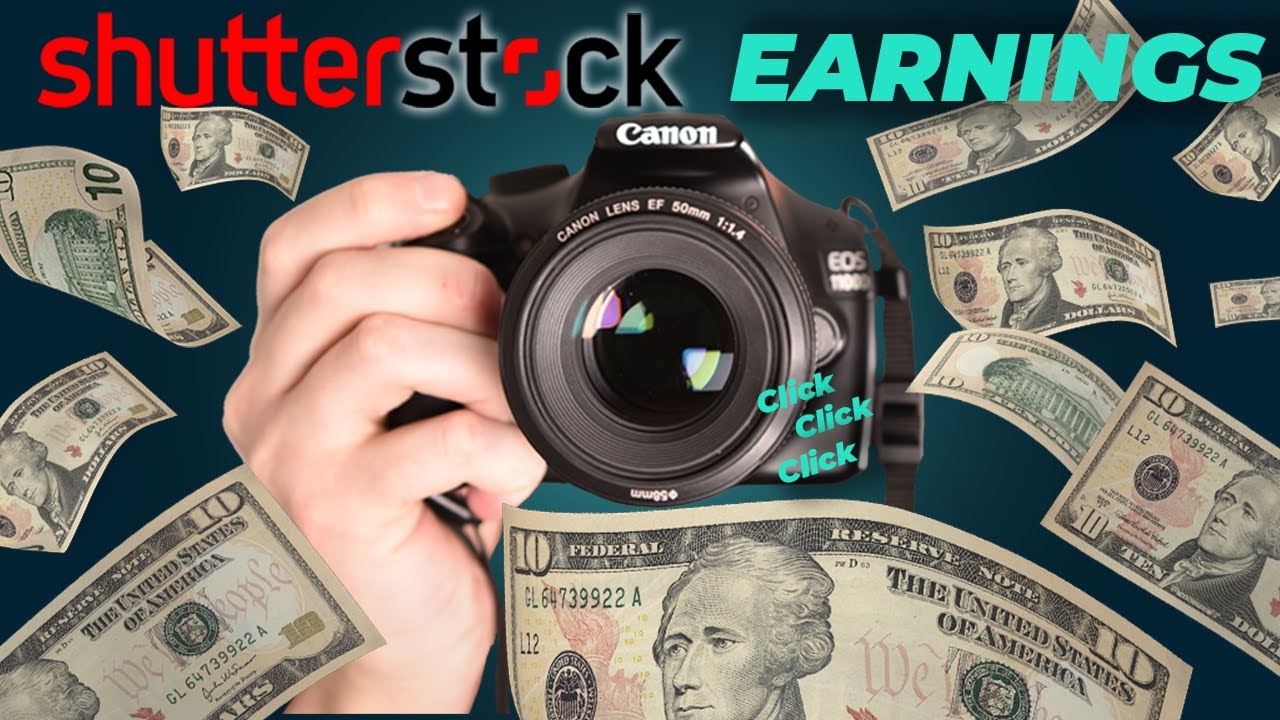If you’re into photography or digital art, you’ve probably heard of Shutterstock. It’s one of the biggest platforms out there for selling stock photos, videos, and illustrations. But how exactly does it work when it comes to earning money? Well, Shutterstock offers a marketplace where contributors upload their creative works, and buyers purchase licenses to use them. The platform then pays contributors a percentage of the license fee. Think of it as a giant digital store where your photos can make you money every time someone licenses them. With millions of users worldwide, it’s a popular choice for photographers looking to monetize their work online.
Factors Influencing Earnings Per Photo on Shutterstock

So, you’re probably wondering, “How much can I really earn per photo?” The answer isn’t straightforward because several factors come into play. Let’s break down the main influences:
- Contributor Level: Shutterstock has a tiered system—Standard, Premier, and Exclusive. Being an exclusive contributor often means higher earnings per download.
- Download Volume: The more your photos get downloaded, the more you earn. Some contributors make a steady income, while others see spikes depending on trends.
- Pricing and Licensing Type: Shutterstock offers Standard and Enhanced licenses. Enhanced licenses tend to pay more, but they’re also less common.
- Subscription vs. On-Demand Downloads: Subscriptions generally offer lower per-download earnings but can lead to higher overall sales volume. On-demand licenses usually pay more per sale.
- Content Quality and Niche: High-quality, unique, or trending content tends to perform better. Niche topics with less competition can also earn more per photo.
- Promotion and Visibility: How well your portfolio is optimized for search and how actively you promote your work can significantly impact your earnings.
In general, Shutterstock contributors earn anywhere from a few cents to several dollars per download. The average is often cited around $0.25 to $2.00 per image for standard licenses, but top contributors or exclusive artists can earn more. Remember, building a diverse and high-quality portfolio increases your chances of higher earnings per photo. It’s not just about luck; consistent effort and understanding what sells can make a big difference in your earning potential in 2025 and beyond.
Average Earnings for Contributors in 2025

So, you’re probably wondering, “How much can I really make per photo on Shutterstock in 2025?” Well, the truth is, it varies quite a bit depending on several factors like the type of content you upload, its quality, and how often you contribute. But to give you a clearer picture, let’s break down the typical earnings for contributors this year.
On average, contributors earn around $0.25 to $0.45 per download. This might not sound like a lot at first glance, but the magic happens when your photos become popular or are in high demand. If your image gets downloaded multiple times, your earnings can really add up!
Here’s a quick snapshot of what you might expect:
- New Contributors: Usually earn between $0.25 and $0.35 per download during their initial months.
- Established Contributors: With a solid portfolio and popular images, earnings can increase to around $0.40 to $0.45 per download.
- Top Sellers: Some high-performing photographers see earnings upwards of $0.50 per download, especially if their images are featured in high-volume categories.
Keep in mind, your total earnings also depend on how many downloads your photos receive. If you have a niche that’s in high demand—like business, technology, or health-related images—you might find your photos are downloaded more often, boosting your income.
Moreover, Shutterstock offers exclusive and non-exclusive licensing options, which can influence your earnings. Exclusive contributors tend to earn higher royalties, often around 30% of the sale price, whereas non-exclusive contributors earn a bit less, typically 15-20%. Understanding these nuances can help you strategize your uploads better.
In summary, while the per-photo earnings might seem modest, the real earning potential lies in building a large, high-quality portfolio and consistently uploading images that resonate with buyers. The more popular your photos become, the more you stand to earn—making it a fantastic platform for passionate photographers and creators looking to turn their hobby into income in 2025.
Tips to Maximize Your Income from Shutterstock Photos

If you’re serious about earning more from your Shutterstock uploads, you’ll want to adopt some smart strategies. Here are some practical tips to help you maximize your income in 2025:
- Create High-Quality, Unique Content: Focus on producing crisp, well-lit, and original images. Avoid overused themes and try to find fresh angles or niche topics that haven’t been saturated yet.
- Research Market Demand: Use Shutterstock’s trending sections and keyword data to identify what buyers are looking for. For example, if sustainability or remote work visuals are trending, tailor some of your content accordingly.
- Optimize Your Keywords and Titles: Proper keywording is essential. Use relevant, specific keywords that accurately describe your photos. The right tags help your images appear in search results, increasing downloads.
- Upload Consistently: Regular uploads keep your portfolio active and increase visibility. Set a manageable goal, like uploading a few high-quality images each week.
- Focus on Popular Categories: Photos related to business, technology, health, and lifestyle tend to have higher demand. Diversify within these categories to attract a broader audience.
- Leverage Trends and Seasonal Content: Create images around upcoming holidays, events, or trending topics. Seasonal and timely content often gets more downloads during peak periods.
- Engage with the Community: Participate in forums or Shutterstock’s contributor resources. Networking can give you insights into what’s working well for others and new opportunities.
- Consider Exclusive Licensing: If you have standout images, think about licensing them exclusively. This can boost your royalty rate and overall earnings for those specific images.
- Analyze Your Performance: Regularly review your download stats and identify which images perform best. Use this data to guide future content creation.
Remember, patience and persistence are key. Building a successful portfolio on Shutterstock takes time, but with consistent effort and strategic thinking, you can significantly boost your earnings in 2025. Think of it as turning your passion for photography into a reliable source of income—one well-placed photo at a time!
Understanding Shutterstock Payment Structure and Royalties

When it comes to earning money on Shutterstock, understanding their payment structure and how royalties work is key to maximizing your income. Shutterstock operates on a royalty-based system, meaning every time someone downloads your photo, you earn a percentage of the sale. But it’s not just a flat rate—you’ll want to get familiar with the details to see how your efforts translate into earnings.
Shutterstock’s payment model is primarily based on a tiered royalty system. As your contributor portfolio grows and your lifetime earnings increase, your royalty rate also improves. Here’s a quick breakdown:
| Lifetime Earnings | Royalty Rate |
|---|---|
| Up to $500 | 15% |
| $500 – $2,500 | 20% |
| $2,500 – $10,000 | 30% |
| Over $10,000 | 40% |
This means that as you sell more images and your earnings grow, you’re rewarded with higher royalty percentages. Keep in mind, the actual payout also depends on the type of license the buyer chooses—Standard or Premium. Premium licenses typically generate higher payouts.
Another important aspect is the payout threshold. Shutterstock pays contributors once they reach a minimum of $35. Payments are processed monthly, usually around the 15th of each month, provided you’ve met the minimum earnings threshold. Payments can be received via PayPal, Skrill, or bank transfer, depending on your location and preferences.
To get the most out of your photos, it’s helpful to understand what sells best and how to optimize your submissions. Keep an eye on trending topics, high-demand niches, and popular styles. Also, the more exclusive your content, the better your chances of earning higher royalties, especially if you participate in exclusive licensing options.
In summary, Shutterstock’s royalty system rewards dedicated contributors with increasing earnings as they build their portfolio and sales. By understanding the tiers, license types, and payout processes, you can strategize better to boost your income in 2025.
Comparison with Other Stock Photography Platforms
So, how does Shutterstock stack up against other popular stock photography platforms? If you’re looking to diversify your income streams, it’s helpful to know the differences in payout structures, licensing options, and overall earning potential across platforms like Adobe Stock, Getty Images, iStock, and Alamy.
Shutterstock remains one of the most popular and accessible platforms for photographers and designers. Its tiered royalty system, large customer base, and straightforward submission process make it a favorite among contributors. As discussed earlier, earnings can range from 15% to 40%, depending on your total sales and exclusivity.
Adobe Stock offers a slightly different approach. Contributors earn 33% of the sale price for each download, which can be quite lucrative given Adobe’s vast user base. Adobe Stock also integrates seamlessly with Creative Cloud apps, making it easy for designers to use your images directly in their projects.
Getty Images and iStock (which is owned by Getty) tend to focus more on premium, high-quality content. Getty offers higher payout rates—up to 30-40% royalty for exclusive contributors—making it attractive if you have high-end or exclusive images. However, the application process is more selective, and the platform caters to a more niche market.
Alamy is known for its generous royalty rates, often paying contributors 40-50% of the sale price. It also has a broad range of content types, including editorial images, which can be quite profitable. The platform is user-friendly, and its flexible licensing options appeal to a wide audience.
Comparison Table
| Platform | Royalty Rate / Earnings | Exclusive Option | Additional Notes |
|---|---|---|---|
| Shutterstock | 15% – 40% | Optional | Large marketplace, tiered system |
| Adobe Stock | 33% | No | Seamless integration with Adobe apps |
| Getty Images / iStock | Up to 30-40% (exclusive contributors) | Yes | High-end, premium market niche | Alamy | 40-50% | No | Flexible licensing, editorial focus |
Each platform has its strengths. Shutterstock offers enormous exposure and flexible licensing, making it ideal for beginners and seasoned contributors alike. Adobe Stock is great for designers who want quick integration into their workflow. Getty and Alamy cater to high-end and editorial content, often providing higher royalty rates but with more selective submission criteria.
Ultimately, the best approach is to diversify across multiple platforms. This way, you can tap into different audiences, licensing types, and sales opportunities. In 2025, understanding these differences will help you make smarter decisions about where to upload your images and how to maximize your earnings.
Conclusion and Future Trends in Stock Photography Earnings
As we look towards 2025, the landscape of stock photography earnings continues to evolve rapidly. While current average payouts per photo can vary significantly based on factors such as image quality, licensing type, and contributor experience, there are promising signs for photographers willing to adapt and innovate. Emerging trends suggest that personalized, niche-specific imagery will command higher prices, and platforms are increasingly rewarding high-quality, exclusive content.
Many photographers are exploring new revenue streams like exclusive licensing, subscription models, and microstock sales, which collectively can boost overall earnings. Additionally, advancements in AI and machine learning are streamlining the process of creating and marketing stock photos, making it easier for contributors to optimize their portfolios.
Looking ahead, several future trends could influence earnings in the stock photography industry:
- Increased demand for authentic and diverse imagery reflecting global cultures and lifestyles.
- Integration of AI-generated images offering new opportunities and challenges for traditional contributors.
- Enhanced platform features for better licensing options, analytics, and creator support.
- Growing importance of video content alongside photos, opening additional revenue avenues.
In conclusion, staying adaptable and continuously updating your portfolio with relevant, high-quality images will be key to maximizing earnings in 2025 and beyond. As the industry shifts, those who embrace innovation and niche markets will be best positioned to benefit from emerging opportunities.

